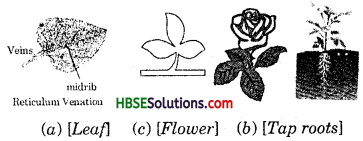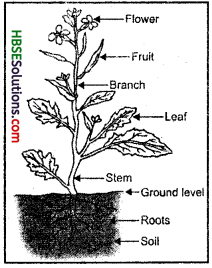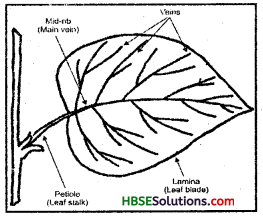Haryana State Board HBSE 6th Class Science Solutions Chapter 7 Getting to Know Plants Textbook Exercise Questions and Answers.
Haryana Board 6th Class Science Solutions Chapter 7 Getting to Know Plants
HBSE 6th Class Science Getting to Know Plants Textbook Questions and Answers
Exercises
Question 1.
Correct the following statements and rewrite them in your note book.
(a) Stem absorbs water and minerals from the soil.
(b) Leaves hold the plant upright.
(c) Roots conduct water to the leaves.
(d) The number of petals and sepals in a flower is always equal.
(e) If the sepals of a flower are joined together, its petals are joined to the petals.
(f) If the petals of a flower are joined together then the pistil is joined to the petal.
Answer:
(a) Root absorbs water and minerals from the soil.
(b) Stem hold the plant upright.
(c) Stem conduct water to the leaves.
(d) The number of sepals and petals in a flower are equal.
(e) If the sepals of a flower are joined together its petals not joined together.
(f) If the petals of a flower joined together, its pistil not joined together.
Question 2.
Draw (a) a leaf, (b) a tap root and (c) a flower.
Answer:

Question 3.
Can you find a plant in your house or in your neighbourhood. Which has long but a weak stem? Write its name. In which category would you classify it?
Answer:
The plant found in our house is money plant, which has weak and long stem. Such type of stem need support and they are called climbers. Guard plant and grapevine also have climber stems.
![]()
Question 4.
What are the function of a stem in a plant?
Answer:
Functions of a stem in a plant:
- It forms a link between the roots and the other parts of a plant.
- It provides path for the conduction of water and minerals absorbed by roots to different parts of the plant.
- It bears leaf in such a way that they get maximum sunlight and support them.
- It upholds the plant upright.
- It bears the flowering parts of the plants.
Question 5.
Which of the following leaves have reticulate venation?
Wheat, Tulsi, Grass, Dhania, China rose, Maize.
Answer:
Tulsi, Dhania, China rose.
Question 6.
If a plant has fibrous root, what type of venation do its leaves likey to have?
Answer:
Parallel venation.
Question 7.
If a plant has leaves with reticulate venation, what kind of roots will it have?
Answer:
The root of plants will be tap root.
Question 8.
Is it possible for you to recognize the leaves without seeing them? How?
Answer:
Yes, we can recognize the leaves without seeing. We can recognize leaves by touching or by smelling.
Examples: Sugarcane, Bananas, Maize, Tulsi, Podina, Dhania etc.
Question 9.
Write the names of the parts of a flower:
Answer:
Parts of a flower : (i) Sepals (ii) Petals (iii) Stamens (iv) Pistil
Question 10.
Which of the following plants have you seen? Off those you have you have seen, which one have flowers.
Answer:
Do it your self.
Question 11.
Name the part of the plant which produces its food. Name this process.
Answer:
Leaf, produces their own food. The process of producing food by leaves is called photosynthesis.
Question 12.
In which part of a flower you likely to find the ovary?
Answer:
The ovary is found in pistil part of a flower.
![]()
Question 13.
Name two flowers each with joined and separated sepals.
Answer:
(a) Flowers with joined sepals are (i) sunflower, (ii) cotton.
(b) Flowers with separate sepals: (i)Rose, (ii) Mustard plant.
Question 14.
Names the parts of the plant which are hidden in this grid. Search for them by going up and down or even diagonally forward as well as backward. Have fun,
Answer:
Do it your self.
HBSE 6th Class Science Getting to Know Plants Important Questions and Answers
Very Short Answer Type Questions
Question 1.
What are herbs?
Answer:
Small and non woody plants are called herbs.
Question 2.
Name any two herbs.
Answer:
Wheat, balsam.
Question 3.
Define shrubs.
Answer:
Medium sized plants within branches starting just above the ground.
Question 4.
Name any three shrubs.
Answer:
Heena, lemon and bougainvillea.
Question 5.
Define trees.
Answer:
Woody plants having a large single stem, which grows for some distance from the ground.
Question 6.
Give examples of three trees.
Answer:
Neem, Mango, Coconut.
Question 7.
What are non-flowering plants?
Answer:
The plants which do not bear flowers.
Question 8.
Give two examples of non-flowering plants.
Answer:
Algae, moss, fern.
![]()
Question 9.
Name two climbers.
Answer:
Money plant, bean stalk.
Question 10.
What are creepers?
Answer:
Plants which need support to stand up are called creepers.
Question 11.
What is conduction?
Answer:
The process through which water travels through stem to other parts of the plants.
Question 12.
What is leaf venation?
Answer:
The design made by veins in a leaf is called leaf venation.
Question 13.
What is node?
Answer:
The part of stem where branches and leaf attached are called nodes.
Question 14.
Define internode.
Answer:
The part of stem between two nodes is called internodes.
Question 15.
Define alternate arrangement of leaves.
Answer:
When one leaf is attached to each node, it is called alternate arrangement.
Question 16.
What is opposite arrangement of leaves?
Answer:
When two leaves arise at each node, it is called opposite arrangement.
Question 17.
What is whorled arrangement?
Answer:
When several leaves are arranged is at a node, it is called whorled arrangement.
Question 18.
Name some plants which have aerial roots.
Answer:
Sugarcane, banyan tree and money plant.
Question 19.
How many root systems are found in plants?
Answer:
Two types:
- Tap root system
- Fibrous root system.
Question 20.
Define tap root system.
Answer:
When a plant has a main root and smaller ones come out from it.
Question 21.
What are lateral roots?
Answer:
Smaller roots which come from tap root.
![]()
Question 22.
Name two roots that we eat as food.
Answer:
Radish, Sweet potato.
Question 23.
Name two underground stems.
Answer:
Potato, yams.
Question 24.
Name one plant which stores food in their leaves.
Answer:
Onion.
Question 25.
Which part of a flower makes fruit?
Answer:
Pistil.
Question 26.
Name the parts of a flower.
Answer:
Sepals, petals, stamen and pistil.
Question 27.
Name any three parts of the leaf.
Answer:
Three parts of the leaves are : (i) Lamina (ii) Midrib (iii) Petiole.
Question 28.
Leaves are …………. in colour.
Answer:
Leaves are green in colour.
Question 29.
Leaves prepare their food by a process called ………..
Answer:
Photosynthesis.
Question 30.
What type of response does not plant touch-me-not show on touching?
Answer:
When we touch the plant of touch- me-not, it folds its leaves quickly. It shows stimuli towards touch.
Question 31.
Name two animals with heterotrophic mode of nutrition.
Answer:
- Cow
- camel
- buffalo.
Question 32.
Which part of the leaf helps in exchange of gases?
Answer:
The lower part of leaf contains many minute pores, which are called stomata. These stomata help in exchange of gases.
![]()
Question 33.
List one common feature of the living and non-living objects.
Answer:
Living and non-living both have mass, shape and occupy space.
Question 34.
Name any two waste products of plants.
Answer:
- Latex
- Gum.
Question 35.
List one characteristic of living things.
Answer:
Living things reproduce.
Question 36.
Why do animals need food?
Answer:
Animals need food for growth and getting energy for doing various activities.
Question 37.
What is a cell?
Answer:
Structural and functional unit of life is called cell.
Question 38.
What is nutrition?
Answer:
The process of taking food is generally called nutrition.
Question 39.
What is respiration?
Answer:
The process of taking oxygen and giving out carbon dioxide from the body is called respiration.
Question 40.
Define excretion.
Answer:
Removal of harmful and poisonous substances from the body with the body organs is called excretion.
Question 41.
What is the food of fishes?
Answer:
Fishes feed on micro-organism and aquatic insects.
Question 42.
What is the food of frog?
Answer:
Small insects.
![]()
Question 43.
Represent photosynthesis by a chemical equation.
Answer:

Question 44.
Name one organism whose body consists of only one cell.
Answer:
Amoeba.
Question 45.
What are autotrophs?
Answer:
Living organisms (green plants) that prepare their own food.
Question 46.
What are heterotrophs?
Answer:
Living organisms (non-green plants and animals) that cannot prepare their own food.
Question 47.
Define respiration.
Answer:
Respiration is the process by which living organisms make energy.
Question 48.
What is stimulus?
Answer:
A change that produces a reaction in an organism.
Question 49.
Where do we get energy for doing work?
Answer:
We get energy from the food we take.
Question 50.
How do plants get their food?
Answer:
Plants get their food from the soil with the help of roots.
Question 51.
What happens when CO2 is passed in lime water?
Answer:
Lime water turns milky.
Question 52.
Why do fish come on the surface in an aquarium?
Answer:
They come to take air.
Question 53.
Why is it necessary to remove waste materials from the body?
Answer:
Since some materials may be poisonous and harmful to the organism.
Question 54.
How does amoeba remove wastes from its body?
Answer:
Amoeba removes wastes through body surface.
![]()
Question 55.
How do plants remove their waste products?
Answer:
They remove their wastes in the form of latex and gum.
Question 56.
What is the process of removal of wastes by plants called?
Answer:
The process of removal of wastes in plants is called secretion.
Question 57.
How does a rose plant reproduce?
Answer:
Rose plant reproduces by cutting.
Short Answer Type Questions
Question 1.
Write a note of the need of plant classification.
Answer:
There are a great variation of plants in their size, shape and structure. So it is essential to classify plants for the ease of their study.
Question 2.
Differentiate between herb, shrub and trees.
Answer:
→ Herbs : Plants with soft stem and small in size. Examples: Tulsi, bean, gram etc.

→ Shrubs :Bushy plants, medium in size and much branched. Examples : Rose, china rose, cotton and sunflower.

→ Trees : Large, branched, wood plants. Examples: Peepal, neem, banyan etc.

Question 3.
What are the functions of leaves?
Answer:
Leaves are known as food factories of plants. They prepare their own food in their green parts using chlorophyll, water and carbon dioxide in the presence of sunlight. This process is called photosynthesis.
Question 4.
Name different parts of a leaf.
Answer:
Normally leaves are flat and green. The main parts of a leaf are:
- leaf lamina
- midrib
- tip
- petiole
- veins
Question 5.
Differentiate between flowering plants and non flowering plants.
Answer:
| Flowering plants | Non-Flowering plants |
| The plants which have roots, stem and leaves, flower and fruits are known as flowering | The plants which do not have definite roots, stem, leaves and flowers are known as non-flowering plants. |
| Examples : Mango, guava, grapes, papaya, banana, jamun etc. | Examples : Fern, moss, algae etc. |
Question 6.
Why does the stem of cactus plant not have leaves?
Answer:
The cactus plant does not have leaves. Its green stem functions as the leaf. Leaves of this plant are modified into spines, which reduce the loss of water for living in dry areas.
![]()
Question 7.
What is the main function of root?
Answer:
Root performs the following functions:
- It fixes the plant in the soil.
- It absorbs water and minerals from the soil for the other parts of the plants.
- It holds the soil firmly, thus prevents soil erosion.
Question 8.
What are the main functions of stem?
Answer:
Functions of stem:
- It forms a link between the roots and other parts of a plant.
- It provides path for the conduction of water and minerals absorbed by roots to different parts of the plant.
- It upholds the plant upright.
- It beau’s leaves in such a way that they get maximum sunlight.
- It bears the floral parts of the plants.
Question 9.
Name the important parts of a flowering plant.
Answer:
The main parts of a flowering plant are:
- Root
- Stem
- Leaf
- Branches
- Flower
- Fruits.
Question 10.
Define supporting roots with examples.
Answer:
In some plants, a number of rope – like roots arisefrom the horizontal branches of the tree. They grow downwards and penetrate the soil acting as pillars to support the main stem and heavy branches of the tree. These roots are called prop roots. These roots are found in banyan tree, sugarcane, screwpine and maize.
Question 11.
Mention some modified roots and stems which we eat.
Answer:
Radish, carrot, potato, sweet potato, beet etc., plant roots storage food, which we eat. In some plants like ginger, onion, potato etc. stems grow underground and store food materials.
Question 12.
What imparts green colour to a leaf?
Answer:
We know that most of the leaves are green in colour. The green colour of leaves is due to a green pigment present in them. This green pigment is called chlorophyll.
![]()
Question 13.
Write three modifications each of stems and leaves.
Answer:
Modifications of roots:
- Storage roots
- Supporting roots
- Breathing roots.
Modification of stems:
- Storage of food
- support
- protection.
Question 14.
What is a fruit? How does it differ from a seed?
Answer:
After fertilization, the ovary of the flower swells up and forms the fruits, like mango, apple, orange etc. The seeds contain a store of food, usually starch. Embryo surrounded by a hard wall with embryo inside is called the seed.
Question 15.
What happens if a green plant does not get sunlight?
Answer:
If a green plant does not get sunlight, it cannot prepare its own food by the process of photosynthesis, and plants and animals will die.
Question 16.
All living organisms need food. Why?
Answer:
All living organisms need food for v’ growth, repair and replacement of worn out cells in the body and energy to perform vital activities. Food provides energy. To perform variety of A activities, animals need food. Plants get. water and minerals from soil through root hairs to their different parts of plants. Green plants prepare their own food with the help of carbon dioxide, water, chlorophyll and sunlight. The process is known as photosynthesis.
Question 17.
Distinguish between locomotion and movement in animals.
Answer:
Difference between locomotion and movement in animals:
| Movement | Locomotion |
| All human beings and animals move from one place to another for food and protection from enemies. For example, birds fly and travel long distances and fish continuously move on water. | The bodily movement involving change of place in animals is called locomotion. Animals use wings (birds), limbs (Horse, cow, buffalo), fins (fish) for locomotion. |
Question 18.
Why are the green plants called autotrophs?
Answer:
Green plants are called autotrophs because they prepare their own food. Green plants utilize carbon dioxide from air, water, mineral from soil and sunlight to prepare their own food in the form of carbohydrate or simple sugar. This process of preparing food is called photosynthesis.
Question 19.
List some common features of living and non-living things.
Answer:
- All livings and non-living things have mass-shape and they occupy space.
- They are made up of structural units.
- The structural units of living and non-living things are cells and particles respectively.
Question 20.
What do you understand by a life span of a living thing?
Answer:
Different organisms have different life spans. The period for which a living being lives is called life span. Animal growth may not occur throughout the life span. Growth in animals is limited and plants and trees grow for a long period. Growth in plants and animals is influenced by several factors.
![]()
Question 21.
List the three differences between living and non-living objects.
Answer:
| Livings | Non-livings |
| 1. Living things grow. | 1. They do not grow. |
| 2. Reproduce to give birth to new one. | 2. They do not reproduce. |
| 3. Living thing shows movements and locomotion. | 3. They do not show movement and locomotion. |
| 4. They respond to stimuli. | 4. They do not respond to stimuli. |
Question 22.
Give three differences between animals and plants.
Answer:
Difference between animals and plants:
| Animals | Plants |
| 1. Animals move from one place to another. | 1. Plants do not move from one place to another. |
| 2. Animals do not make their own food. So they are heterotropbs. | 2. Plants are autotrophs because they prepare their own food. |
| 3. Growth in animals is limited and definite up to a certain age. | 3. Plant growth is unlimited and indefinite. |
Question 23.
State the character on the basis of which animals are divided into two categories.
Answer:
Animals which have a bony skeleton with a back bone are called vertebrates and animals which do not have a long skeleton and a back bone are called invertebrates.
Question 24.
Define excretion.
Answer:
The process of removal of some harmful and poisonous substances from the body is called excretion. In humans, the excretory products are removed from the body in the form of urine and urea.
Question 25.
What do you mean by growth?
Answer:
An increase in size, shape and body mass of an organism is termed as growth. It is an irreversible change in a living organism. The growth in animals is limited and in plants, growth is unlimited and continues till the last stage of life.
Question 26.
What is the difference between the growth of living and non-living?
Answer:
The growth in living beings is internal and irreversible. It is due to multiplication of cells and tissues. The growth in non-living is external and reversible. It is caused due to deposition of particle from outside.
Question 27.
What do you understand by the term ‘nutrition’?
Answer:
All living things depend upon food to survive. The food is the source of energy. The energy is necessory for performing various life activities. Taking of food is called nutrition.
![]()
Question 28.
What is respiration?
Answer:
Respiration is an anabolic activity during which air rich in oxygen is taken into the cell and air rich in CO2 is given out from the cells. The oxygen is used in the oxidation of food which gives us energy.
Question 29.
Define stimulus and response.
Answer:
Any change in our surroundings is a stimulus and any reactions performed by an organism to that stimulus is response. For example the watering of mouth by seeing a tasty food. To leave the road on the left on hearing the sound of a horn. The movement of stem or flower in the direction of sunlight. These characteristics of living forms show responsiveness.
Question 30.
What is cell? What is the difference between unicellular and multicellular organism?
Answer:
The structural and functional unit of life is celled cell. Each cell has a living substance, the protoplasm. Single celled animal is called unicellular and many called organism is called multicellular organism. Example : Amoeba and cow etc.
![]()
Question 31.
Differentiate between autotrophs and heterotrophs?
Answer:
Those organisms which prepare their own food, are called autotrophs. For example : only green plants. Those organisms which cannot prepare their own food and depend upon plants or other animals for their food are called heterotrophs. For example : Man, Bacteria, Fungi, etc.
Question 32.
In what way does the intake of food help living things?
Answer:
Living things perform many activities like, playing, running, etc. The energy is required for all activities of living things. This energy is obtained from the food they take. Thus food gives living things energy. It also helps living beings in repairing the body parts. Food also protects t living things from infections and diseases.
Long Answer Type Questions
Question 1.
Draw a labelled diagram of a plant showing its various parts.
Answer:
The various parts of a plant are shown on the diagram given below:

Question 2.
What is a leaf? Draw the labelled diagram of a leaf. What are the functions of the leaves of a plant?
Answer:
Leaf: The leaf is a thin, broad, flat and green part of a plant which is attached to the stem (or branch).
The leaves of plants have three main functions:
(i) The leaves make food for the plant by photosynthesis.

(ii) The leaves get rid of excess water from the plant through transpiration.
(iii) The leaves carry out the process of respiration in plants.
Getting to Know Plants Class 6 HBSE Notes
- Plants are usually grouped in herbs, shrubs and trees on the basis of their height, stem and branches.
Stem conducts water upwards, bears leaves, buds and flowers. - Leaves have variety of shapes, size and other characteristics.
- The pattern of veins on the leaves is called venation. It can be reticulate or parallel.
- Leaves are attached to the stem at places called nodes. The part of stem between two nodes is called internode.
- The arrangement of leaves at the node is alternate, opposite or whorled.
- Leaves release water vapour by the process of transpiration. They prepare food by the process of photosynthesis from carbon dioxide, water, chlorophyll and sunlight.
- Roots are underground part of the plants. They absorb water and minerals from the soil and hold the soil firmly to keep a plant upright.
- Roots are mainly of two types : Tap root and fibrous root.
- Plants having leaves with reticulate venation have tap root and parallel, venation plants leaves have fibrous root.
- Stem conducts water from the roots to the leaves and food from the leaves to the roots.
- All plants do not have colourful flowers. The parts of flowers are usually present in rings.
- The various whorls are sepals, petals, stamen and pistil. Number of sepals, petals, stamen’s and pistils are different in different flowers.